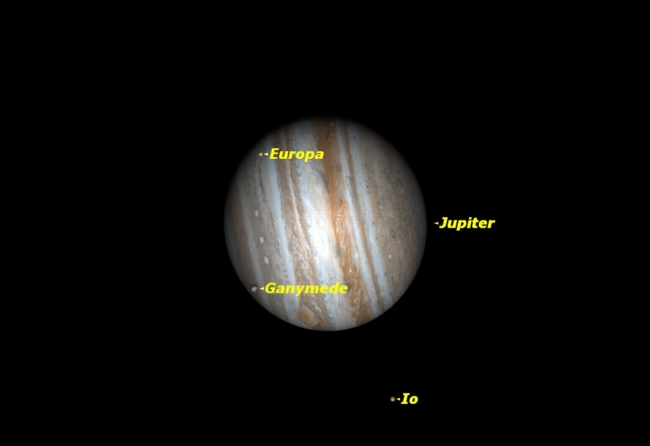Jupiter's Moons Perform Shadowy Waltz Next Week: How to Watch

One of the first sights new telescope owners often observe is the scintillating dance of Jupiter’s moons as they orbit the planet.
Galileo Galilei was the first to observe Jupiter’s four bright satellites, and from them he was able to deduce that they orbited Jupiter. He grasped this as proof positive of Copernicus’ groundbreaking theory that the sun, not the Earth, was the center of the solar system.
Most of the time we see Jupiter’s four bright moons strung in a line on either side of the planet, because we are viewing this miniature solar system edge on.
Inevitably this means that most of the moons will also pass in front of and behind Jupiter once every orbit. When they pass behind Jupiter, the moons are sometimes in the huge shadow of the gas giant, and other times behind the planet itself. In either case, we cannot see them from Earth.
But when the satellites pass in front of Jupiter, many interesting things happen. The inner two satellites, Io and Europa, are highly reflective, even more so than Jupiter itself. This brightness is particularly noticeable when they are just beginning or ending their journey across the face of Jupiter. During these so-called transits, when Io and Europa are near the middle of the planet’s disk, they usually vanish from sight except in the largest telescopes. [Telescope Reviews for Beginners]
The two outer satellites, Ganymede and Callisto, are darker than Jupiter, and so are visible as dark gray spots when viewed against Jupiter’s cloud banks.
The Jupiter system's celestial show
Breaking space news, the latest updates on rocket launches, skywatching events and more!
This can be seen clearly in the computer-simulated image here, where Europa, just entering the disk, is a bright white spot, while Ganymede, leaving the disk, is dark gray.
The graphic depicts an actual transit which will be visible from the west coast of North America in the evening on Jan. 10. The event begins with the entry of Ganymede onto the face of Jupiter at 8:40 p.m. PST (11:40 p.m. EST; 0440 GMT Jan. 11). Incidentally, Jupiter's Great Red Spot will also be well placed for observation at this time.
Ganymede will slowly cross the face of Jupiter until it is joined by the bright Europa at 10:25 p.m. PST (1:25 a.m. EST Jan. 11; 0625 GMT Jan. 11). By then, Jupiter will be low in the west, and will set soon after. Unfortunately for viewers in eastern North America, most of this event will take place after Jupiter sets.
Ganymede will leave the disk of Jupiter at 10:47 p.m. PST (1:47 a.m. EST Jan. 11; 0647 GMT Jan. 11). Europa will follow at 12:53 a.m. PST (3:53 a.m. EST; 0853 GMT), but Jupiter will have set for most North American observers by then.
Viewers in the far northwest may be able to catch the intensely black shadow of Europa as it begins to cross the disk of Jupiter at 3:03 a.m PST (6:03 a.m. EST; 1103 GMT). You will need to be in Hawaii to see the shadow of Ganymede join that of Europa slightly over an hour later, and to follow them across the face of the planet.
Skywatching in 2012
Such a "double feature" with Jupiter’s moons is extremely rare, yet this is actually part of a series of similar skywatching events in 2012, culminating in August when half a dozen such events will occur.
Unfortunately, in most cases, the whole sequence takes place over too long a span of time for an observer in any one location to catch it all, but there will be many opportunities for all of us to catch parts of the shows.
While Jupiter’s moons are easily visible in even the smallest telescopes when they are "off-planet," they require a fair amount of telescope power to be seen while in transit. The satellite shadows, because they are intensely black, can be seen with a 90mm telescope. The darker satellites, Ganymede and Callisto, are visible with a 130mm telescope. In any case, you will need a magnification of at least 150 times to make them out.
All these transit events are predicted in the Observer’s Handbook 2012 of the Royal Astronomical Society of Canada, and in most computer planetarium programs.
This article was provided to SPACE.com by Starry Night Education, the leader in space science curriculum solutions. Follow Starry Night on Twitter @StarryNightEdu.

Geoff Gaherty was Space.com's Night Sky columnist and in partnership with Starry Night software and a dedicated amateur astronomer who sought to share the wonders of the night sky with the world. Based in Canada, Geoff studied mathematics and physics at McGill University and earned a Ph.D. in anthropology from the University of Toronto, all while pursuing a passion for the night sky and serving as an astronomy communicator. He credited a partial solar eclipse observed in 1946 (at age 5) and his 1957 sighting of the Comet Arend-Roland as a teenager for sparking his interest in amateur astronomy. In 2008, Geoff won the Chant Medal from the Royal Astronomical Society of Canada, an award given to a Canadian amateur astronomer in recognition of their lifetime achievements. Sadly, Geoff passed away July 7, 2016 due to complications from a kidney transplant, but his legacy continues at Starry Night.

